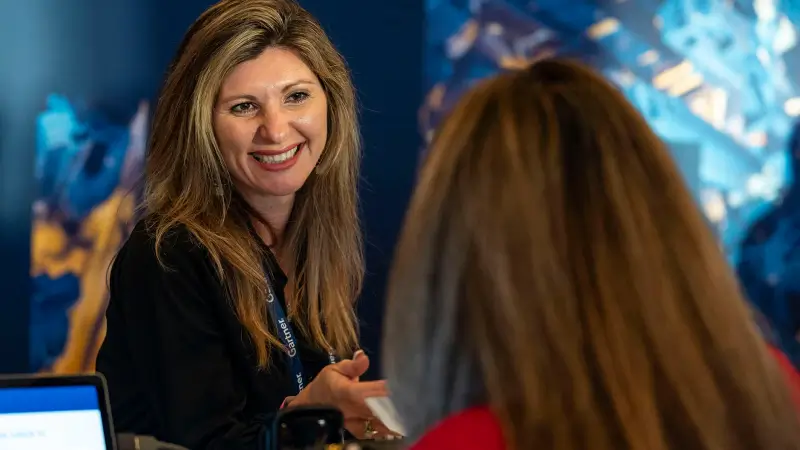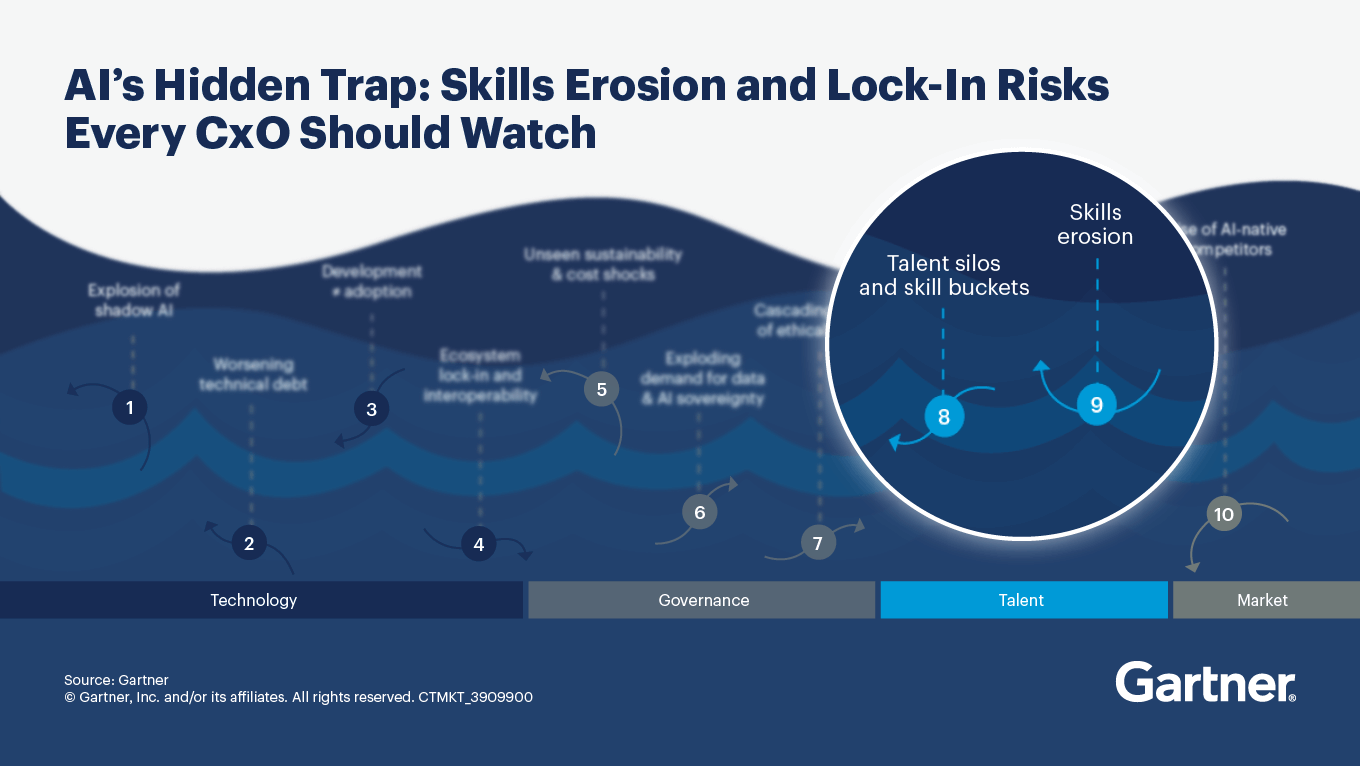And what to do next.
- Gartner client? Log in for personalized search results.
Skill erosion sets the stage for AI lock-in
Gartner warns that as organizations automate more work with AI, they risk losing the expertise in their workforce to question, improve or fix automated outputs — and make innovation possible. This leads to a phenomenon known as “AI lock-in.”
AI lock-in occurs when employees stop practicing foundational tasks and become overly reliant on AI systems. Over time, this dependency leaves businesses vulnerable if AI systems fail or deliver poor results, as the workforce may lack the skills to intervene, adapt, or restore quality.
See our business and technology insights in action at a Gartner conference.
AI dependency rises as human expertise declines
As AI automates both routine and complex tasks, recognizing this growing dependency is critical to preventing costly talent shortages and minimizing business risks.
Talent shortages, rising costs and increased risk lay ahead
Gartner predicts that by 2028, 40% of employees will be trained and coached by AI when entering new roles, up from less than 5% today. While this shift promises faster onboarding and adaptive, scalable learning, it also means fewer chances for employees to learn from experienced peers. Junior staff, who once relied on mentorship and hands-on experience, will learn primarily from AI tools, while senior staff increasingly depend on AI to complete complex work. This shift accelerates the loss of foundational skills and weakens expert mentorship and relationship development across the organization.
It’s not just soft skills that are at risk. By 2030, Gartner predicts half of enterprises will face irreversible skill shortages in at least two critical job roles because of unchecked automation, declining GenAI accuracy and wage suppression. Already, organizations struggle to fill senior roles in software development, recruiting and legal fields — these positions often take 12 to 18 months to hire for. As skill erosion accelerates, expect time-to-hire and costs to rise even higher as the pool of qualified candidates continues to shrink.
The consequences of AI lock-in go beyond hiring
AI agents are already making business decisions, and Gartner projects by 2028, they will handle a full third of them. Without strong human oversight, organizations will struggle to spot and correct AI’s mistakes. This exposes the business to operational errors and reputational damage. Over time, unchecked skill erosion creates a vicious cycle: fewer skilled workers, greater dependence on AI and higher costs to fill critical gaps.
Gartner’s research is clear: The future of work depends on balancing AI-driven efficiency with intentional skill development and retention. Organizations that ignore the risks of skill erosion and AI lock-in will struggle to adapt to market changes, recover from technology failures and maintain long-term competitiveness.
Safeguard critical skills to prevent AI lock-in
Take these steps now to avoid skill shortages and AI lock-in:
Watch for AI mistakes and rising error costs, and keep manual checks in place where AI is used most.
Retain your senior staff and encourage peer learning to slow skill loss.
Focus on roles at risk and review your talent strategies regularly to keep key skills strong.
Pair AI with human oversight and maintain manual checks as a backup for AI.
Encourage employees to continue exercising core skills (e.g., analysis, coding, problem-solving) even when AI tools are available — through simulations, rotations and shadowing.
Use AI simulations and adaptive training, but make sure people still learn from each other.
Organizations that act now will build a resilient, adaptable workforce ready to thrive in a landscape shaped by both human and machine intelligence. Those that balance the use of AI and automation with strong talent strategies move faster, retain skilled talent and lower the risk of costly AI-driven mistakes.
Skill erosion and AI lock-in FAQs
What is skill erosion, and how does it relate to AI lock-in?
Skill erosion occurs when employees lose foundational abilities — in this case, because AI automates key tasks and reduces opportunities for hands-on experience and peer learning. Over time, this loss of expertise leads to “AI lock-in,” where organizations become dependent on AI and lack the human skills to challenge, verify or correct AI outputs.
How can organizations prevent skill erosion and AI lock-in?
Organizations should blend AI automation with manual verification, invest in ongoing training, and work to retain senior staff. Regularly review talent strategies to identify roles at risk, and ensure that opportunities for peer learning and human intervention persist.
Why is AI lock-in a threat to business continuity?
AI lock-in creates a single point of failure. If AI accuracy declines or systems fail, organizations may lack the human skills needed to detect or fix errors, leading to operational and reputational risks.
Attend a Conference
Accelerate growth with Gartner conferences
Gain exclusive insights on the latest trends, receive one-on-one guidance from a Gartner expert, network with a community of your peers and leave ready to tackle your mission-critical priorities.

Drive stronger performance on your mission-critical priorities.
